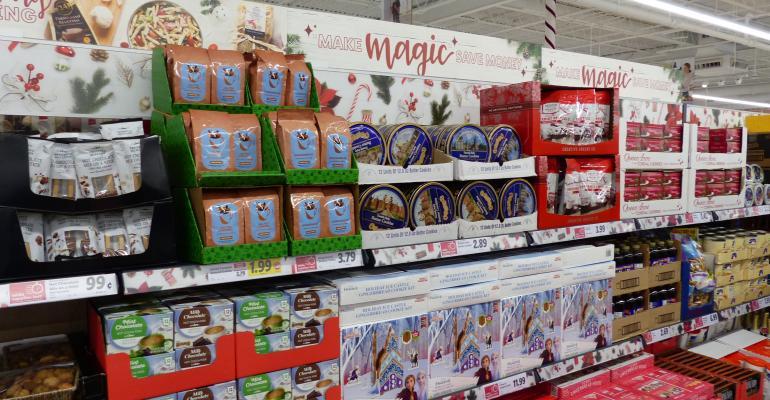Inflated grocery pricing won’t push shoppers to cut back on how much they will spend this holiday season as much as influence how they will go about spending, new research from FMI-The Food Industry Association shows.
Of 1,718 U.S. adults polled earlier this month, 62% said they’re now shelling out more money at grocery stores versus a year ago, according to FMI’s U.S. Grocery Shopper Trends 2022/Holiday Shopping study, done in tandem with The Hartman Group. And looking ahead, 45% reported concern about rising food and beverage prices for their holiday meals, more than for the cost of holiday gifts (43%) or travel (34%).
That’s leading consumers to approach their holiday spending more wisely. With food prices still elevated, 71% of respondents said they plan to adjust their holiday meal shopping, which signals that most shoppers are taking more control of their grocery budgets but can still to find cost-savvy items to meet their needs, FMI noted.

Among the holiday strategies to alleviate higher pricing, 28% of grocery shoppers surveyed cited “looking for deals,” followed by “choosing store brands” (21%) and “enjoying more home-cooked meals” (20%). Other strategies included “making fewer dishes overall,” “substituting more affordable options” and “making fewer dishes” — each named by 17% of respondents — plus “change brands I buy” (16%), “buy more in person” (13%) and “make smaller portions” (13%).
“Food is the centerpiece for so many of our holiday gatherings. Despite inflationary pressures, consumers are determined to enjoy the festivities this year as they normally do,” FMI President and CEO Leslie Sarasin said in a statement. “The food industry is working tirelessly to keep costs down and to ensure that our timeless traditions can continue during this holiday season.”
Though the Consumer Price Index (CPI) saw a bit of a letup for September, the food-at-home CPI remained elevated, up 13% year over year, less than increases of 13.5% in August and 13.1% in July. Month to month, the food-at-home index inched up 0.7% in September, the same as in August — when the monthly gains was the first below 1% since April — but less than 1.3% in July. The U.S. Bureau of Labor Statistics reported that all six major grocery store food group indices for food-at-home rose on a monthly and an annual basis in September.

In the FMI research, 40% of shoppers said COVID-19 will have some impact on their holiday plans, yet this concern is down considerably versus a year ago and has been replaced by worries about inflation. In-stocks also are an issue, as 58% of respondents indicated they’re somewhat concerned about food shortages around the holidays, about the same percentage as last year.
This year, consumers are focusing on planning ahead and shopping early, FMI noted. Thirty-seven percent said they plan to shop earlier than usual this Thanksgiving, and 34% plan to do so for the December holidays. The earlier shopping is aimed at taking advantage of deals and making sure not to come up empty-handed, as 27% of those surveyed are concerned that retailers may run out of favorite holiday foods, a percentage that rises to 43% for households with children.
In the event of missing holiday ingredients, half of shoppers polled reported that they would prepare different foods, up from 47% a year ago, and 36% would look for a new recipe to try, up from 32% last year.

Key findings by holiday included the following:
• Halloween — Among households with kids, 28% aim to buy more candy, 27% to buy/give out less candy, 26% to spend less/not buy a new costume and 24% to spend more on a costume.
• Thanksgiving — Among routine changes for holiday shoppers, 38% plan to buy meat they don’t typically purchase, 16% to buy more expensive ingredients, 37% to shop further in advance, 23% to shop at different food stores for certain items, and 19% to shop at different specialty food stores for specific food or beverage items.
• December Holidays — Of holiday shoppers polled, 34% aim to shop further in advance, 13% plan to order food/beverages online ahead of time, 34% expect to buy meat they don’t typically purchase, 16% may buy more expensive ingredients, 17% expect to shop at different food stores, 20% would shop at different specialty food stores, 14% plan to bring in prepared foods from a food store and 9% would order in from a restaurant.
• New Year’s Eve/Day — Research for these holiday shoppers showed that 21% expect to shop further in advance, 12% aim to order food/beverages online ahead of time, 15% plan to bring in prepared foods from a food store and 11% would order in from a restaurant.
Overall, the study revealed, more than two-thirds of shoppers plan to engage in the holidays “about the same” as last year, marking a year-over-year increase for each holiday, FMI said in the report. And while shoppers generally want to rein in costs, this holiday season they aim to get together with more people, increase travel and shop earlier than normal to a larger degree than last year.





